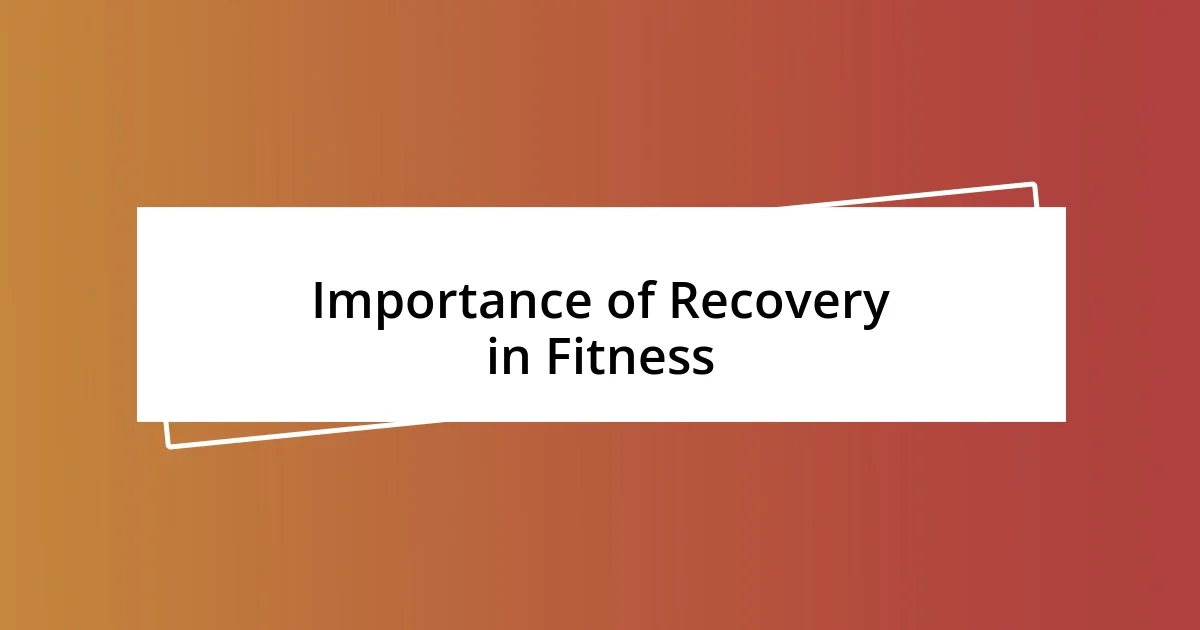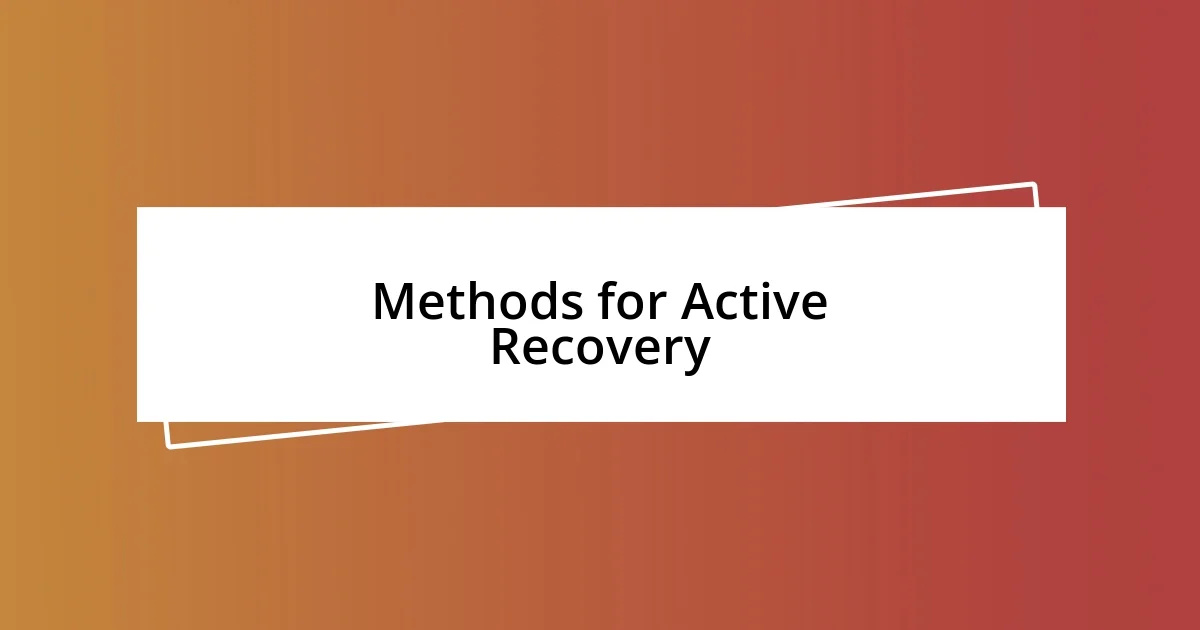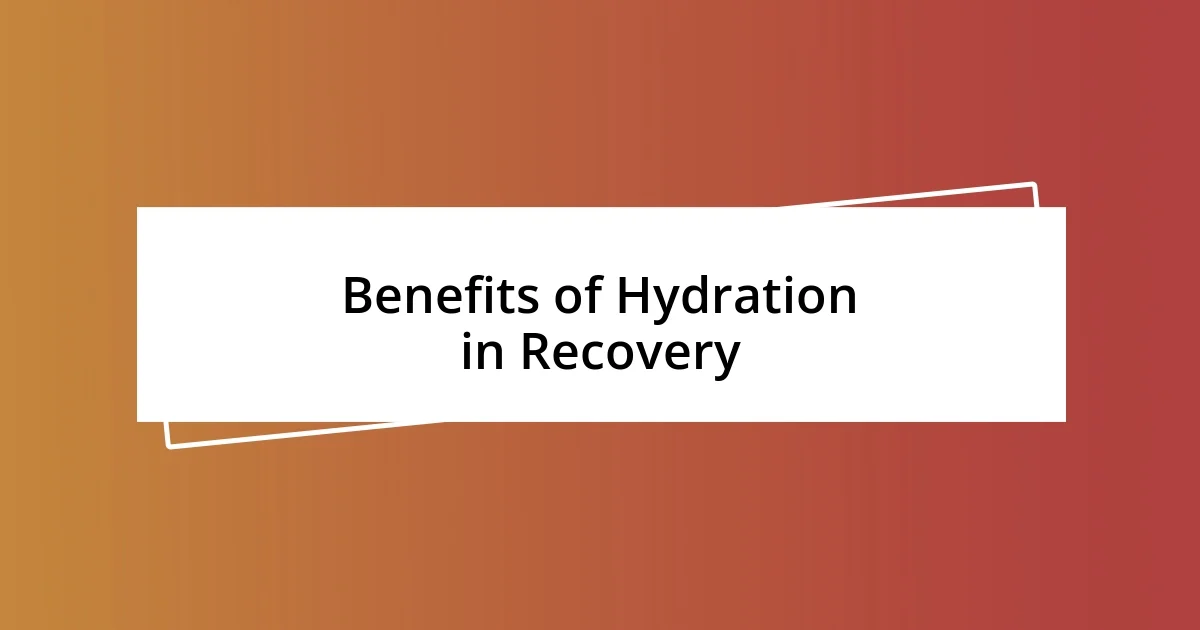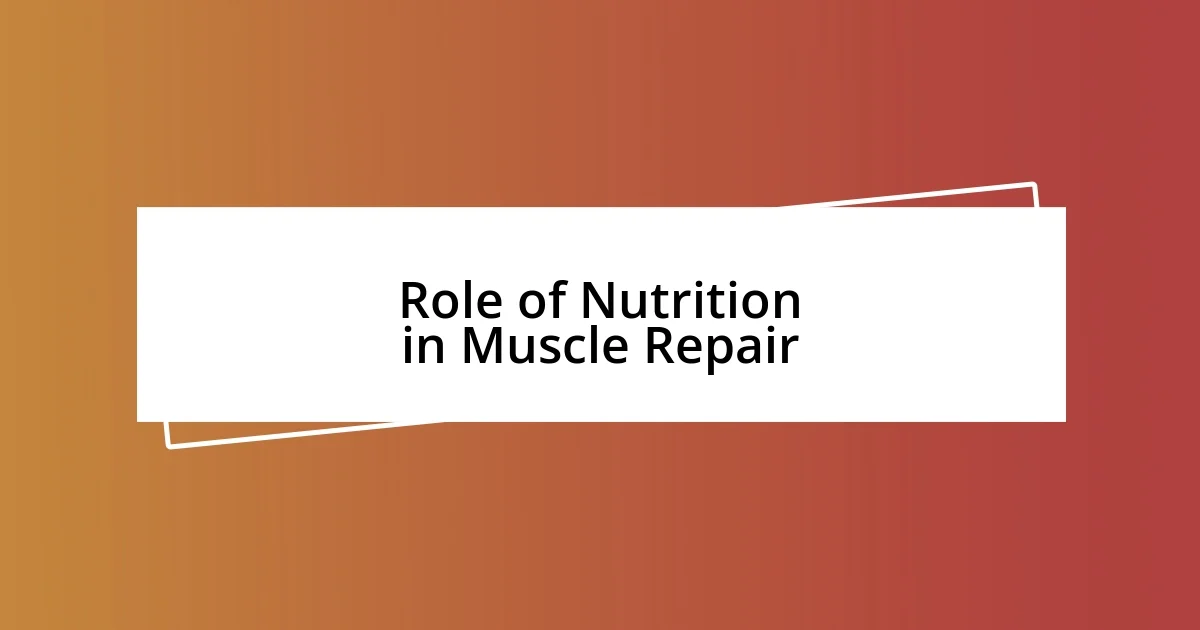Key takeaways:
- Active recovery techniques, such as swimming and yoga, promote blood flow and reduce soreness, essential for overall recovery.
- Proper nutrition post-workout, including protein and carbohydrates, is crucial for muscle repair and replenishing energy levels.
- Mental strategies like visualization and mindfulness meditation help enhance recovery by promoting relaxation and motivation.

Understanding Workout Recovery Techniques
When I first started working out regularly, I quickly realized that pushing my body to its limits wasn’t the only part of the process. Recovery techniques became essential in preventing injuries and allowing me to hit those personal bests repeatedly. Have you ever wondered how some athletes seem to bounce back so quickly? It’s all about smart recovery strategies!
One technique that made a significant difference for me was active recovery. On days when I felt too sore from a tough workout, a light yoga session or a brisk walk acted like magic. It felt as if my body was thanking me for keeping blood flowing without the pressure of intense exercise. I can’t stress enough how important it is to listen to your body; sometimes, a little movement can lead to greater gains than just resting on the couch.
Another method I’ve come to appreciate is proper nutrition post-workout. Early on, I underestimated the power of a good recovery meal. After a long run, I vividly remember enjoying a protein-packed smoothie. The relief I felt as I replenished my body with nutrients was almost tangible. Reflecting on these experiences, I realize that recovery is not just a phase; it’s a vital aspect of our fitness journey that requires intention and care.

Importance of Recovery in Fitness
Recovery plays a pivotal role in fitness, often underestimated by many. From my own experience, I’ve learned that without adequate recovery, progress can stagnate, and fatigue can set in. I remember a time when I ignored my body’s need for rest; I ended up fatigued and frustrated, which taught me that recovery is not just a break—it’s an integral part of progress.
Moreover, incorporating recovery techniques like stretching and foam rolling after workouts has significantly enhanced my performance. I still recall the days when I would skip post-workout stretches; my muscles would feel tight and sore the next day. Now, I’ve made it a habit to dedicate a few minutes to these techniques, and the difference in how I feel the following day is astounding.
Lastly, understanding that recovery serves both physical and mental aspects has been a game changer for me. Just recently, I took a week off from intense workouts. It was hard, I won’t lie, but returning to the gym felt exhilarating! I realized that allowing my mind to reset could lead to increased motivation. This balance is essential—mental recovery is just as crucial as physical recovery in a fitness journey.
| Recovery Technique | Importance |
|---|---|
| Active Recovery | Promotes blood circulation and reduces soreness. |
| Proper Nutrition | Helps replenish lost nutrients and aids muscle repair. |
| Stretching and Foam Rolling | Enhances flexibility and prevents muscle tightness. |
| Mental Rest | Boosts motivation and reduces burnout. |

Methods for Active Recovery
One of my go-to methods for active recovery is gentle swimming. There’s something incredibly soothing about gliding through the water that revitalizes my body. I remember a particularly grueling leg day; instead of hitting the gym the next day, I opted for a light swim. The buoyancy of the water eased my sore muscles, and I could feel the tension melt away with each lap.
Another fantastic active recovery technique that I’ve come to love is cycling at an easy pace. Just a few weeks ago, I decided to take my bike out for a leisurely ride after a tough workout week. It wasn’t about pushing my limits but rather enjoying the fresh air and letting my legs unwind. I was surprised at how revitalizing that simple ride felt. Here are some methods for active recovery that you might find valuable:
- Swimming: Low-impact movement that promotes relaxation and reduces soreness.
- Cycling: Engages the muscles gently while allowing them to recover.
- Yoga: Focuses on stretching and breathing, which helps to alleviate tension.
- Walking: An easy way to increase blood flow and keep muscles engaged without strain.
- Light Weightlifting: Using lower weights aids muscle recovery while maintaining movement.
Active recovery doesn’t have to be intense. Listening to my body and engaging in these gentle activities has made a profound impact on my overall recovery journey.

Benefits of Hydration in Recovery
Hydration is often overlooked, yet it plays a crucial role in recovering from workouts. Personally, I’ve noticed a significant difference in how I feel when I consistently drink enough water. After a long run, I remember feeling utterly depleted until I gulped down some fluids; within minutes, my energy levels began to bounce back. It’s fascinating how something so simple can make a huge impact!
When we sweat, we’re not just losing water; we’re also losing essential electrolytes, which are vital for muscle recovery and overall well-being. Have you ever felt that odd cramp after an intense workout? I used to experience those quite often, especially during summer months, until I started paying closer attention to my hydration strategy. I learned that replenishing lost fluids not only alleviates those painful cramps but also aids in reducing inflammation and promoting quicker healing.
Moreover, keeping hydrated helps with mental clarity, which I truly appreciate post-workout. I recall feeling foggy-headed after my training sessions because I hadn’t drank enough. Once I made it a habit to hydrate before, during, and after workouts, the brain fog lifted, and I could focus better on my daily tasks. It’s incredible how the right amount of hydration can clear my mind and inspire my next workout!

Role of Nutrition in Muscle Repair
Nutrition is a cornerstone of muscle repair, and I can’t stress enough how it has transformed my recovery process. After a challenging workout, I make it a point to consume protein-rich foods to kickstart muscle recovery. I vividly remember one post-gym meal where I whipped up a protein shake complemented by a banana. Within minutes, I felt my body thanking me, almost as if my muscles were rejoicing over the nutrients they craved.
Carbohydrates also play a pivotal role in the recovery equation. I’ve experienced firsthand how a good balance of carbs post-workout can replenish glycogen stores, which is essential for muscle repair. After a particularly intense weightlifting session, I dove into a bowl of quinoa mixed with some roasted veggies. It was amazing how replenishing those carbs not only restored my energy but also improved how my body felt in the following days. Meals like this have become a ritual for me.
Let’s not forget about healthy fats, either. They are crucial for overall health and can greatly aid in reducing muscle soreness. I’ll sometimes add avocado to my post-workout salads or blend it into smoothies. The creaminess is delightful, but it’s the way it helps me feel nourished that keeps me coming back for more. Have you noticed how certain foods not only fuel your body but also uplift your spirit? That’s been my experience, and I believe it underscores the profound connection between nutrition and recovery.

Effective Stretching and Foam Rolling
Effective stretching and foam rolling can be game-changers in my recovery routine. I remember the first time I truly dedicated time to stretching after a workout; it felt like a warm hug for my muscles. The tension that I normally felt the following day just vanished. Stretching not only improves flexibility but also enhances blood flow, which speeds up recovery. Has anyone else noticed how deep stretching can ease the soreness that creeps in after a tough session? It’s like giving my muscles the love and attention they deserve.
Foam rolling, on the other hand, adds a whole new layer to my recovery strategy. Initially, I was a bit intimidated by it, thinking it would be painful. However, after my first session, I was pleasantly surprised by its benefits. I specifically recall rolling out my hamstrings after a long run; the knots that had built up loosened with every roll, and I felt an immediate sense of relief wash over me. Foam rolling not only targets those pesky tight spots but also encourages the body to release tension and recover more effectively.
In exploring these techniques, I’ve discovered that consistency is vital. I try to incorporate both stretching and foam rolling into my post-workout routine, and it’s made a noticeable difference in how I feel. The days I skip them, I end up paying the price with tighter muscles and sluggish energy levels. Have you found a routine that works for you? I encourage you to experiment and see how these simple yet effective tools can enhance your own recovery journey.

Mental Strategies for Enhanced Recovery
When it comes to mental strategies for recovery, visualization has been a game-changer for me. After an intense workout, I take a few moments to close my eyes and visualize my muscles healing and getting stronger. It’s almost like giving my body a mental pep talk, and I’ve found that this practice not only calms my mind but also instills a sense of confidence in my recovery process. Have you ever tried visualizing your recovery? It can turn your post-workout routine into a powerful mental exercise.
Another technique I’ve embraced is mindfulness meditation. I set aside just five to ten minutes to focus on my breath and the sensations in my body post-workout. The peace that washes over me during these moments feels rejuvenating. A recent experience sticks out—one day, after a particularly grueling HIIT session, I sat quietly and noticed how grateful I felt for my body’s capabilities. This practice has taught me to appreciate the journey of recovery, which, in turn, makes the challenges seem much more manageable.
Journaling my thoughts on recovery has also significantly contributed to my mental approach. Writing down how my body feels after workouts and my emotional state helps me process my experiences better. I remember after one tough training week, I poured my heart onto the pages, recognizing patterns in my fatigue and motivation. Reflecting on that experience helped me realign my goals and adjust my strategies. Have you ever written down your recovery journey? It’s a fantastic way to connect with yourself and track your progress.














